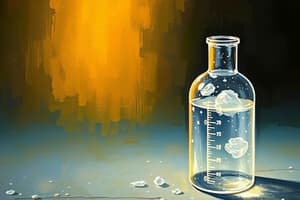Podcast
Questions and Answers
According to the Arrhenius concept, what does an acid produce when dissolved in water?
According to the Arrhenius concept, what does an acid produce when dissolved in water?
- Hydroxyl ions (OH-)
- Sodium ions (Na+)
- Chloride ions (Cl-)
- Hydrogen ions (H+) (correct)
Which of the following is a limitation of the Arrhenius acid-base theory?
Which of the following is a limitation of the Arrhenius acid-base theory?
- It is valid for all compounds.
- It accurately describes proton transfer in all reactions.
- It can be applied to any solvent.
- It only applies to reactions in aqueous solutions. (correct)
What ion characterizes an acid, according to the text?
What ion characterizes an acid, according to the text?
- Hydronium ion (correct)
- Hydroxide ion
- Chloride ion
- Sodium ion
According to the Bronsted-Lowry theory, what is an acid?
According to the Bronsted-Lowry theory, what is an acid?
What is a conjugate base formed from?
What is a conjugate base formed from?
According to Lewis theory, which of the following defines a base?
According to Lewis theory, which of the following defines a base?
In the reaction $CH_3COOH + H_2O
ightleftharpoons H_3O^+ + CH_3COO^-$, which substance is the acid?
In the reaction $CH_3COOH + H_2O ightleftharpoons H_3O^+ + CH_3COO^-$, which substance is the acid?
What is the process called when water molecules react with each other to form hydroxonium and hydroxide ions?
What is the process called when water molecules react with each other to form hydroxonium and hydroxide ions?
What is a base according to Arrhenius theory?
What is a base according to Arrhenius theory?
What is a conjugate acid?
What is a conjugate acid?
What is the symbol for the ionic product of water?
What is the symbol for the ionic product of water?
What is the value of Kw at 25 degrees Celsius?
What is the value of Kw at 25 degrees Celsius?
In an acidic solution, what is the concentration of hydronium ions ([H3O+]) compared to $1.0 \times 10^{-7}$ moldm-3?
In an acidic solution, what is the concentration of hydronium ions ([H3O+]) compared to $1.0 \times 10^{-7}$ moldm-3?
What is the value of pKw?
What is the value of pKw?
The strength of an acid or base is determined by what measurement?
The strength of an acid or base is determined by what measurement?
What does pH measure?
What does pH measure?
What characterizes a strong acid or base?
What characterizes a strong acid or base?
What is the pH of a neutral solution?
What is the pH of a neutral solution?
What is the formula to calculate pH?
What is the formula to calculate pH?
What does Ka represent?
What does Ka represent?
What is the effect of concentration changes on dissociation constants?
What is the effect of concentration changes on dissociation constants?
What happens when a base (A-) is dissolved in water?
What happens when a base (A-) is dissolved in water?
What does a large Kb value indicate?
What does a large Kb value indicate?
What formula relates pH and pOH?
What formula relates pH and pOH?
What does a smaller pKa value indicate?
What does a smaller pKa value indicate?
What is the relationship between Ka and Kb?
What is the relationship between Ka and Kb?
According to Ostwald's dilution law, what is the relationship between the degree of dissociation ($\alpha$) and concentration (C)?
According to Ostwald's dilution law, what is the relationship between the degree of dissociation ($\alpha$) and concentration (C)?
What is the formula for calculating pH of an acidic buffer?
What is the formula for calculating pH of an acidic buffer?
What type of solution resists changes in pH upon addition of small amounts of acid or base?
What type of solution resists changes in pH upon addition of small amounts of acid or base?
What is the formula for calculating pOH of a basic buffer?
What is the formula for calculating pOH of a basic buffer?
A solution containing ethanoic acid and sodium ethanoate will act as what?
A solution containing ethanoic acid and sodium ethanoate will act as what?
Flashcards
Arrhenius Acid
Arrhenius Acid
A substance that dissolves in water to produce hydrogen ions (H+).
Arrhenius Base
Arrhenius Base
A substance that dissolves in water to produce hydroxide ions (OH-).
Limitation of Arrhenius Theory
Limitation of Arrhenius Theory
Acids and bases are only defined in terms of ions formed when dissolved in water.
Bronsted-Lowry Acid-Base Theory
Bronsted-Lowry Acid-Base Theory
Signup and view all the flashcards
Bronsted-Lowry Acid
Bronsted-Lowry Acid
Signup and view all the flashcards
Bronsted-Lowry Base
Bronsted-Lowry Base
Signup and view all the flashcards
Conjugate Acid
Conjugate Acid
Signup and view all the flashcards
Conjugate Base
Conjugate Base
Signup and view all the flashcards
Lewis Acid
Lewis Acid
Signup and view all the flashcards
Lewis Base
Lewis Base
Signup and view all the flashcards
Self-ionization of Water
Self-ionization of Water
Signup and view all the flashcards
Ionic Product of Water (Kw)
Ionic Product of Water (Kw)
Signup and view all the flashcards
Acidic Solution ([H3O+])
Acidic Solution ([H3O+])
Signup and view all the flashcards
Neutral Solution ([H3O+] & [OH-])
Neutral Solution ([H3O+] & [OH-])
Signup and view all the flashcards
Basic Solution ([H3O+])
Basic Solution ([H3O+])
Signup and view all the flashcards
pH Scale
pH Scale
Signup and view all the flashcards
What is pKw?
What is pKw?
Signup and view all the flashcards
What defines a strong Acid/Base?
What defines a strong Acid/Base?
Signup and view all the flashcards
What defines a weak Acid/Base?
What defines a weak Acid/Base?
Signup and view all the flashcards
What is Ka?
What is Ka?
Signup and view all the flashcards
Ka Formula
Ka Formula
Signup and view all the flashcards
What affects dissociation constants?
What affects dissociation constants?
Signup and view all the flashcards
What is Kb?
What is Kb?
Signup and view all the flashcards
Kb values
Kb values
Signup and view all the flashcards
Ka * Kb
Ka * Kb
Signup and view all the flashcards
pKa/pKb and Strength
pKa/pKb and Strength
Signup and view all the flashcards
Ostwald Dilution Law
Ostwald Dilution Law
Signup and view all the flashcards
Buffer Solutions
Buffer Solutions
Signup and view all the flashcards
Buffering Capacity (B)
Buffering Capacity (B)
Signup and view all the flashcards
Acidic Buffers
Acidic Buffers
Signup and view all the flashcards
pH of Acidic Buffer
pH of Acidic Buffer
Signup and view all the flashcards
Basic Buffers
Basic Buffers
Signup and view all the flashcards
Study Notes
- CHE 101 explores the nature of acids and bases.
Concepts of Acid and Base
- S.A. Arrhenius proposed in 1884 that an acid is a substance that dissolves in water to produce hydrogen ions (H+) and corresponding negative ions.
- HCl, HNO3, and H2SO4 are typical acids that dissociate in water to yield hydrogen ions and their negative counterparts.
- A base produces hydroxyl ions (OH-) with corresponding positive ions when dissolved.
- KOH, NaOH, and Ca(OH)2 are examples of bases.
Limitations of Arrhenius Theory
- The theory is inapplicable to reactions outside aqueous solutions.
- Acids and bases are defined by ions in water.
- Free protons (H+) do not exist; non-solvated hydrogen ions cannot exist in solution.
- Hydroxonium ion (H3O+) characterizes an acid.
- The base definition is valid only for hydroxides, excluding compounds like ammonia gas and sodium carbonate, which can be neutralized without containing OH- ions.
Bronsted – Lowry Acid-Base Theory
- J.N. Bronsted and T.M. Lowry independently proposed that acids and bases bring about an improvement in the Arrhenius definition.
- It is based on proton transfer.
- An acid donates a proton when dissolved in a solvent (base).
- A base accepts a proton when dissolved in a solvent (acid).
- A conjugate acid is a corresponding base that gains a proton.
- A conjugate base is a corresponding acid that loses a proton.
Lewis Acid-Base Theory
- G.N. Lewis proposed the concept of acids and bases based on the sharing of an electron pair.
- An acid accepts a lone pair of electrons.
- This forms a co-ordinate covalent bond from the donor substance (base).
- BF3 is an example.
- A base donates a lone pair of electrons.
- This forms a co-ordinate covalent bond.
- NH3 is an example.
Water Equilibrium (Dissociation of water)
- Pure water is neutral
- It ionizes slightly to yield equal concentrations of hydroxonium and hydroxyl ions.
- Equilibrium exists between water molecules and the ions they form, which is self-ionization.
- The equilibrium constant of H2O is constant.
- The constant Kw, or [H3O+][OH-], refers to the Ionic Product of water or water dissociation equilibrium constant.
- If concentration is in moldm-³, then the unit of Kw is mol²dm-⁶.
- The numerical value depends on temperature, but it is 1.0 x 10-14 at 25°C for pure water.
- In acidic solutions, [H3O+] > 1.0 x 10-7 moldm-3.
- In neutral solutions, [H3O+] = [OH-] = 1.0 x 10-7 moldm-3.
- In basic solutions, [H3O+] < 1.0 x 10-7 moldm-3.
The pH Scale
- S.L. Sorenson suggested that the concentration of H3O+ ions should use the pH scale in 1909.
- The pH of a solution is the negative logarithm of the hydroxonium concentration in moldm-3.
- It measures the degree of acidity of a solution.
- pOH is the negative logarithm of the hydroxide ion concentration in moldm-3, measuring the degree of alkalinity.
- Lower pH indicates higher hydroxonium ion concentration and acidity.
- Acidic solutions have a pH value below 7.
- Basic solutions have a pH value above 7.
- A solution with pH of 7 is neutral.
- pH = - log [H3O+] = log 1/[H3O+]
- pOH = - log [OH-] = log 1/[OH-]
- At 25°C, Kw = 1.00 x 10-14
- pKw = - log Kw = - log (1.00 x 10-14).
- pKw = 14
- pKw = - log Kw = pH + pOH = 14
- pH + pOH = 14
Strength of Acids and Bases
- Strength is determined by the measurement of electrical conductivity.
- Strong acids/bases dissociate completely in solution with a stable conjugate base/acid.
- Weak acids/bases dissociate partially with an unstable conjugate base/acid.
- Relative strengths are determined by comparing dissociation constants.
- When an acid HA is dissolved in water, it will dissociate to form hydroxonium ion and an anion.
- A- + H2O НА + ОН
- The strength of a base (A-) also varies with concentration of the hydroxide ion [OH-] produced on dissociation.
- Weak acids have the concentration of water is constant.
- ais the acid equilibrium constant for dissociation of an acid and called the dissociation constant of an acid.
- Dissociation constants are unaffected by concentration changes just like pH but influenced only by temperature changes.
Relationship between Kₐ, K♭ and K𝑤
- A relationship exists between the water dissociation equilibrium constant, Kₐ, and the base dissociation equilibrium constant, K♭, of the conjugate base of the acid.
- Use HA as a weak acid and find the equilibrium expression.
- The equilibrium expression for conjugate base A- of the acid in water is: Kb = [HA] [OH-] / [A-]
- Strength is measured by pKa and pKb values; smaller values equal stronger acids or bases.
-
- log Ka - log Kp = - log Kw = 14
- pKa + pKp = pKw = 14 (at 25°C).
Ostwald Dilution Law
- The degree of dissociation (α) of a weak electrolyte is proportional to the inverse square root of the concentration (C), or the square root of the dilution.
- The concentration of any one ionic species is given by the root of the product of the dissociation constant and the concentration of the electrolyte.
- α = ν (kd/C)
- [H3O+] = VKaC
- [OH-] = VkbC
Buffer Solutions
- A buffer resists changes in hydrogen ion concentration or pH upon the addition of acid or alkaline substances.
- Buffering Capacity (B) is the magnitude of a buffer action
- Buffering Capacity (B) is measured by the amount of strong base required to alter the pH by one unit.
- There are acidic and basic buffers.
Acidic Buffers
- Mixing a weak acid and its salt of a strong base prepares it.
- Examples are ethanoic acid and sodium ethanoate.
- A solution is acidic and resists changes in pH.
- pH = pKa - log ([Acid]/[Salt]) OR pH = pKa + log ([salt]/[Acid])
Basic Buffers
- Mixing a weak base and its salt of a strong acid prepares alkaline buffers.
- Aqueous ammonia and ammonium chloride are examples.
- A solution is basic and resists pH changes in a basic medium.
-
- log [OH-] = - log Kb - log ([Base]/[Salt])
- pOH = pKb + log ([Salt]/[Base])
Studying That Suits You
Use AI to generate personalized quizzes and flashcards to suit your learning preferences.




